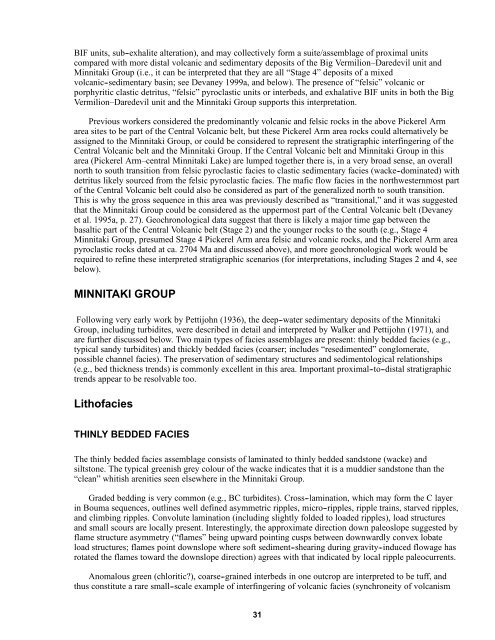Regional Geology, Sioux Lookout Orogenic Belt - Geology Ontario
Regional Geology, Sioux Lookout Orogenic Belt - Geology Ontario
Regional Geology, Sioux Lookout Orogenic Belt - Geology Ontario
Create successful ePaper yourself
Turn your PDF publications into a flip-book with our unique Google optimized e-Paper software.
BIF units, sub--exhalite alteration), and may collectively form a suite/assemblage of proximal units<br />
compared with more distal volcanic and sedimentary deposits of the Big Vermilion–Daredevil unit and<br />
Minnitaki Group (i.e., it can be interpreted that they are all “Stage 4” deposits of a mixed<br />
volcanic--sedimentary basin; see Devaney 1999a, and below). The presence of “felsic” volcanic or<br />
porphyritic clastic detritus, “felsic” pyroclastic units or interbeds, and exhalative BIF units in both the Big<br />
Vermilion–Daredevil unit and the Minnitaki Group supports this interpretation.<br />
Previous workers considered the predominantly volcanic and felsic rocks in the above Pickerel Arm<br />
area sites to be part of the Central Volcanic belt, but these Pickerel Arm area rocks could alternatively be<br />
assigned to the Minnitaki Group, or could be considered to represent the stratigraphic interfingering of the<br />
Central Volcanic belt and the Minnitaki Group. If the Central Volcanic belt and Minnitaki Group in this<br />
area (Pickerel Arm–central Minnitaki Lake) are lumped together there is, in a very broad sense, an overall<br />
north to south transition from felsic pyroclastic facies to clastic sedimentary facies (wacke--dominated) with<br />
detritus likely sourced from the felsic pyroclastic facies. The mafic flow facies in the northwesternmost part<br />
of the Central Volcanic belt could also be considered as part of the generalized north to south transition.<br />
This is why the gross sequence in this area was previously described as “transitional,” and it was suggested<br />
that the Minnitaki Group could be considered as the uppermost part of the Central Volcanic belt (Devaney<br />
et al. 1995a, p. 27). Geochronological data suggest that there is likely a major time gap between the<br />
basaltic part of the Central Volcanic belt (Stage 2) and the younger rocks to the south (e.g., Stage 4<br />
Minnitaki Group, presumed Stage 4 Pickerel Arm area felsic and volcanic rocks, and the Pickerel Arm area<br />
pyroclastic rocks dated at ca. 2704 Ma and discussed above), and more geochronological work would be<br />
required to refine these interpreted stratigraphic scenarios (for interpretations, including Stages 2 and 4, see<br />
below).<br />
MINNITAKI GROUP<br />
Following very early work by Pettijohn (1936), the deep--water sedimentary deposits of the Minnitaki<br />
Group, including turbidites, were described in detail and interpreted by Walker and Pettijohn (1971), and<br />
are further discussed below. Two main types of facies assemblages are present: thinly bedded facies (e.g.,<br />
typical sandy turbidites) and thickly bedded facies (coarser; includes “resedimented” conglomerate,<br />
possible channel facies). The preservation of sedimentary structures and sedimentological relationships<br />
(e.g., bed thickness trends) is commonly excellent in this area. Important proximal--to--distal stratigraphic<br />
trends appear to be resolvable too.<br />
Lithofacies<br />
THINLY BEDDED FACIES<br />
The thinly bedded facies assemblage consists of laminated to thinly bedded sandstone (wacke) and<br />
siltstone. The typical greenish grey colour of the wacke indicates that it is a muddier sandstone than the<br />
“clean” whitish arenities seen elsewhere in the Minnitaki Group.<br />
Graded bedding is very common (e.g., BC turbidites). Cross--lamination, which may form the C layer<br />
in Bouma sequences, outlines well defined asymmetric ripples, micro--ripples, ripple trains, starved ripples,<br />
and climbing ripples. Convolute lamination (including slightly folded to loaded ripples), load structures<br />
and small scours are locally present. Interestingly, the approximate direction down paleoslope suggested by<br />
flame structure asymmetry (“flames” being upward pointing cusps between downwardly convex lobate<br />
load structures; flames point downslope where soft sediment--shearing during gravity--induced flowage has<br />
rotated the flames toward the downslope direction) agrees with that indicated by local ripple paleocurrents.<br />
Anomalous green (chloritic?), coarse--grained interbeds in one outcrop are interpreted to be tuff, and<br />
thus constitute a rare small--scale example of interfingering of volcanic facies (synchroneity of volcanism<br />
31

















